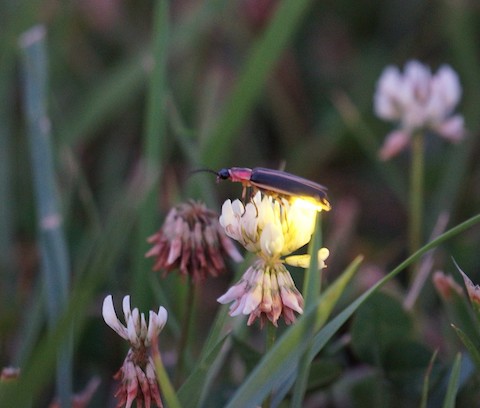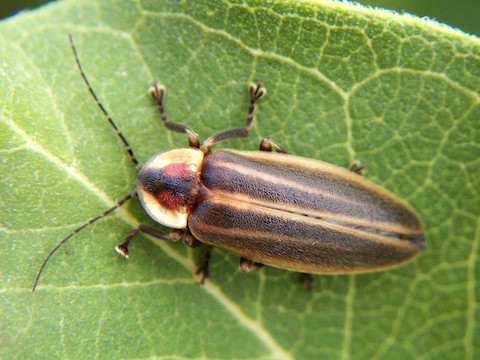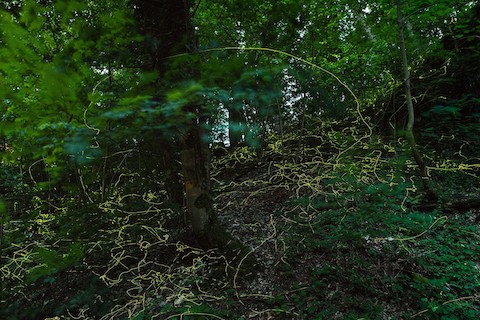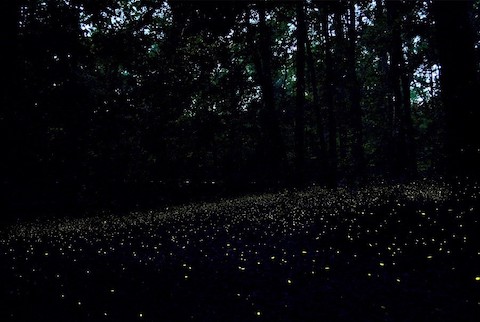
Fireflies are sometimes called lighting bugs or glowworms. But they’re not flies, bugs or worms—they’re beetles, with a marvelous capability.
They move oxygen through a tube in their abdomen to combine it with a special pigment called luciferin to produce bioluminescence, the familiar glow that gives fireflies their name.
There are 2,000 species of firefly around the world and 170 in the US. Different species produce different colored light, from bright red to fluorescent green.
And they flash their light differently too.
Males of some species blink their own unique message, hovering a few feet in the air, signaling to females on the ground, who flash back. When the language is right, the male flies down to the female to mate.
In different species, the males synchronize their flashing, all sending the same message at the same time. It’s thought that this brighter light gives females a better look at their suitors.
Once mated, the females lay eggs. The larvae grow underground, then the immature beetles crawl around in leaf litter, eating worms and slugs, before they mature and take flight.
If you’d like to see fireflies around your house this summer, provide a good environment.
Don’t spray pesticides, which kill fireflies and other beneficial insects.
Allow the grass to grow longer and leave some leaf litter around trees.
Then keep your outside lighting low: a dark yard will invite fireflies to flash their unique language of love.
Background
Synopsis: In early summer, fireflies fascinate viewers of all ages with forest light shows. Some species synchronize their dance, flashing on and off in unison throughout the woods. Fireflies are beetles that use chemistry to produce a cold light in their abdomen. Like morse code, the sequence of flashes sends messages that helps them to locate mates of their own species. Fireflies need forest litter to develop into adults and darkness to see the messages of their species, so habitat loss and light pollution threaten them, along with pesticide use.
- Fireflies are also known as lightning bugs in the U.S. and glowworms in Europe, but they are not flies, bugs, or worms; they are beetles.
- There are more than 2,000 species of the soft-bodied bioluminescent beetle order called Lampyridae around the world, with about 170 species in North America.
- North American fireflies are more common in the eastern United States than in the western United States.

- Bioluminescence refers to the ability of some organisms to produce light biochemically.
- Fireflies make light in special cells in their abdomens by mixing oxygen with a pigment called luciferin, an enzyme called luciferase, and the energy carrying molecule adenosine triphosphate (ATP).
- Light is a byproduct of the chemical reaction, along with an inactive molecule called oxyluciferin.
- Most entomologists believe fireflies control the timing of their flashing by regulating how much oxygen goes to their light-producing organs through a tube in the abdomen called the abdominal trachea.
- The wavelengths of light produced by these beetles are between 510 and 670 nanometers depending on the species, ranging from bright green to deep red.
- Crystals of uric acid in the light producing cells reflect the light produced by the chemical reaction away from the beetle’s body.
- In addition to these beetles, many other organisms evolved separately to produce bioluminescence using similar biochemical reactions. Around 90% of deep-sea creatures are thought to be bioluminescent.
- Lightning bugs light up for a variety of reasons, depending on their stage of life.
- As larvae, glowworms flash a pale lime green light to warn predators that they contain toxic or bitter chemicals.
- As adults, they use flash patterns to identify themselves as a specific species, and they look for matching sequences to find mates.
- For protection, some fireflies create chemicals called lucibufagins that taste terrible and can be toxic, so predators quickly learn to avoid the flashing beetles. If placed in a person’s mouth, some fireflies cause numbness for about an hour.

- The best time to see fireflies in action is in the early summer.
- Their larvae live underground in winter then move to leaf litter on forest floors to mature, finally emerging in late May and early June.
- The timing of their annual emergence is correlated with temperature and rainfall.
- They thrive in warm humid conditions when plentiful snails, slugs, earthworms and pill bugs provide food for the young adults.
- Mild winters are easier on larvae survival, resulting in larger populations of blinking adults.
- The brightest firefly displays occur on the warmest nights because as cold-blooded creatures they are most active when it is warmer.
- Each species of firefly has a specific signaling routine.
- Typically, males fly at a specific height in a specific habitat at a specific time using a specific flash pattern, and females on the ground flash the pattern back with a precisely timed delay.
- The pair repeats the signal to each other in a courtship light show as the male flies down toward the female. If all the coded signals are correct, they mate.
- Some flash for hours, while others only flash for about 20 minutes at dusk.
- Many species deliver their flash patterns independently, causing the forest to twinkle, but some species produce a synchronized show, with all the males flashing together.
- In the synchronized species, scientists think all the beetles flash together to give the females time to look at all the males and then signal when they spot a prospective mate.
- The most famous of these coordinated shows are put on by beetles in the genus Photinus in the Great Smoky Mountains National Park along the North Carolina–Tennessee border and in Congaree National Park in South Carolina.
- Not only do they all flash the same pattern together, but they all stop flashing at the same time, just like an orchestra stops at the end of a piece when the conductor signals. But who is conducting the beetles?

- Magical fireflies are under threat from several sources, many of which humans can help to control.
- Fireflies depend on specific habitats in forests, meadows and marshes to remain undisturbed for the year it takes them to complete their life cycle. Some females are wingless so can’t fly away to find a better habitat. Larvae depend upon soil biota, the organisms in the soil, to thrive, so if their habitat is destroyed during larval stages entire populations may be terminated. Climate wackiness is a real threat to them.
- Artificial lighting creates light pollution that may make it difficult for fireflies to see the flashes produced by potential mates. This risk is especially dire in Asia and South America as urban centers spread into wildlands.
- Insecticide applications for mosquito control may also kill fireflies.
- Fire ants live in the same soil zones and have been known to eat firefly larvae, so as they invade habitats the ants may reduce firefly populations.
- Droughts and heatwaves cause stress in the egg and larval stages that may delay emergence or kill off populations before they can emerge.
- If you have seen fireflies in your area, there are probably eggs in garden or woodland soil, so you can encourage their life cycle with a few simple strategies.
- Keep lights off on the exterior of your house and close blinds to decrease light coming from inside the house.
- Use only natural fertilizers and keep leaf litter around trees and plant more trees to create more habitat.
- Introduce earthworms into your garden; they are a favorite food of firefly larvae.
- Avoid using pesticides on your lawn since eggs may be buried there.
- Leave your lawn longer and incorporate longer grasses in your garden to attract the adults.
- Fireflies like humidity so gather in wet soils around ponds where they also find abundant food sources. Avoid using chlorine or mosquito insecticide in ponds.

